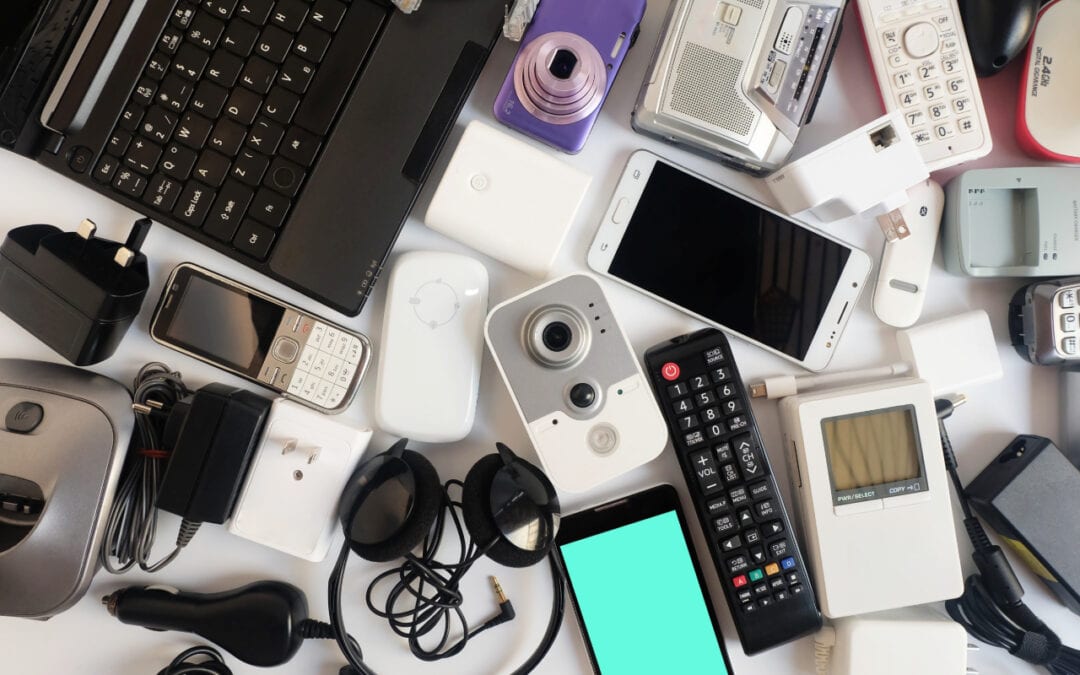We’ve partnered with the Recycle Your Electricals campaign to encourage more people to reuse and recycle their waste electrical and electronic equipment (WEEE). What exactly is WEEE, and where does it end up when we throw it away?
WEEE, also referred to as e-waste, is basically any waste item that has electrical components, circuitry or a power supply. This includes:
- Smart devices and IT e.g. mobile phones, laptops, printers and cables.
- Household appliances e.g. toasters, kettles, irons and vacuum cleaners.
- Entertainment devices e.g. TVs, cameras, DVD players, speakers and electric toys.
- Personal grooming appliances e.g. hair dryers, electric toothbrushes and electric shavers.
- DIY and gardening equipment e.g. electric drills, lawnmowers and high-pressure hoses.
- Large ‘white’ goods e.g. washing machines, fridge freezers and dishwashers.
- Lighting and lightbulbs.
- Batteries and battery packs.
The list is almost endless. In total we generate 1.45 million tonnes of WEEE in the UK each year. The numbers are growing. Globally, 54 million tonnes of WEEE was generated in 2019, an increase of 21% in just five years. Due to our increasing consumption of electronics, shorter device lifetimes and limited repair options, global WEEE is expected to reach a staggering 74 million tonnes by 2030.
The good news is that anything with a plug, battery or cable can technically be recycled. This is as long as it ends up in the right place. The right place is a designated repair, reuse or recycling point. The wrong place is the general waste bin.
When WEEE goes wrong
When WEEE is thrown away it ends up in landfills or is incinerated, resulting in valuable resources being lost forever. Electrical items contain gold, silver, copper and many other precious metals, which we should be doing our utmost to keep in circulation. Retrieving them from old equipment means we can reuse them in new items and reduce our reliance on the difficult and environmentally damaging process of mining them from the ground. In fact, if we recovered all the copper and gold from WEEE being thrown away in Europe, we would have more than enough for all of the new electrical equipment Europe purchases each year.
Unfortunately, around 40% of the WEEE generated in the UK isn’t reused or recycled. Each year, households and businesses discard over 330,000 tonnes, some illegally exported. Some of it finds its way to toxic e-waste dumps in developing countries, where local communities are exposed to dangerous chemicals from unsafe recycling techniques.
Getting it right
There is a better way. Most unwanted or broken electrical items can usually be repaired with the right tools. The more electricals we reuse in our community, the less damage we do to the environment (and our pockets!).
If reuse isn’t viable or items can’t be returned to the original retailer or manufacturer, accredited reprocessors can recycle WEEE. They break down items into component parts, recovering valuable resources for use in new products.
Join our campaign
As part of the Recycle Your Electricals campaign, we’re inviting our customers and partners to set up amnesty collection hubs on their premises so staff and families can bring in their unwanted small electricals from home.
Everything we collect will be assessed for reuse and then either repaired or sent to our accredited reprocessors, so you can be sure your WEEE ends up in the right place. In the meantime, you can find your nearest collection point here.
By hosting a collection point you can play a vital role in tackling electrical waste and helping us to build a greener, circular economy. If you’re interested in taking part or would like to know more, please contact us via recycling@emergemanchester.co.uk or call 0161 223 8200.

